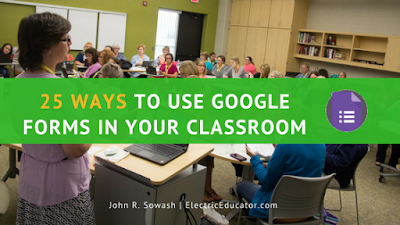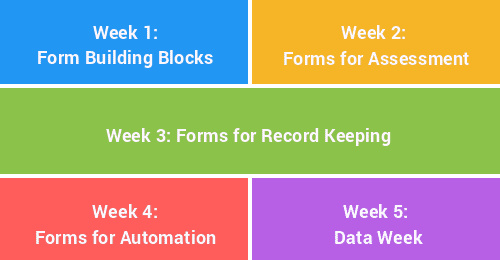25 Ways to use Google Forms in the Classroom (with examples!)

Google Forms is one of my favorite classroom tools.
But here's the deal - most teachers aren't taking full advantage of what Google Forms has to offer!
You have probably used Forms to create a survey or give a quiz, but that's not all Forms can do!
Here are 25 different ways you can use Google Forms in your Classroom - with an example for each!
I also created a PDF version of this post with links, images, and an option to make a copy of each form. Click here and I'll send it to you via email!
1. Reading Quiz - Hold students responsible for reading assignments by giving a simple quiz. This example is based on Fahrenheit 451 in a high school English classroom and is configured to release the quiz score immediately after submitting the quiz.
2. Image-based Technology Quiz - This quiz uses images to test basic Chromebook literacy. It is set up so that the student immediately receives their score and can see which questions they got wrong.
Tech & Learning Newsletter
Tools and ideas to transform education. Sign up below.
3. Bell ringer / Do now activity - This morning math check in activity is completed by students first thing in the morning before the start of class. The form uses data validation to provide hints if the student is struggling to get the correct answer.
4. Mood Check-in - Students will have a difficult time learning if the arrive at school filled with worry and concern. This mood check in provides a safe space for students to share their current mood and concerns with you. By using a tool like Form Postman you can configure the form to send you an email if a student indicates a negative emotion.
5. Permission slips - Field trips are fun. Permissions slips are not. This form allows parents to digitally sign permission slips. In an effort to prevent students from completing their own permission slip a parent email address is required and a notification is sent to this email address using Form Postman.
Choice eliminator is used to remove student names from the drop-down list once a parent has given their permission. This makes it easy for a teacher to identify which students do not have a permission slip on file.
6. Book report generator - Writing reflectively is a key component of the common core standards. A book report is a tremendous way to help students practice reflective, informational writing, and to also encourage them to identify elements of literature such as genre, plot, and setting. As a bonus, they can share their writing with others!
This form provides a simple way for students to share their thoughts on a book that they have read. I am using a tool called AutoCrat to take the form submissions and turn it into a nicely formatted Google Doc which can be easily printed or shared electronically.
7. Meeting Agenda Generator - For principals, department heads, and school administrators, organizing and running meetings is a lot of work. You can streamline the process of creating meeting agendas and minutes using Google Forms!
This meeting generator is completed by the meeting organizer. Using AutoCrat and FormMule, attendees are automatically notified with the meeting details and invited to add their agenda items to the agenda document. These documents are named, organized, and accessible in Google Drive.
8. Certificate Creator - Creating certificates is a pretty common tasks in education. Whether honoring students for their academic or athletic achievement or documenting professional development activity. Forms is a convenient way to generate certificates.
This simple example collects your name and email address to generate a simple certificate in Google Docs which is emailed to you as a PDF.
9. Customized Writing Assignments - Use Google Forms to generate custom research assignment based on topics that interest your students. This form asks students to answer several simple questions which are used to generate a unique research assignment based on their answers.
10. Course Evaluation - Good teachers seek feedback and constantly work to improve their course. This is the course evaluation form that I use to solicit feedback on my online courses. This form takes advantage of question branching; based on your answer to a question the form splits to ask additional follow up questions (i.e. indicating that you would like a sticker takes you to the address section).
11. Call for Speakers Form - If you help organize a conference or professional development day you can use Google Forms to collect session descriptions. This example is carefully designed to collect all of the information that is used to create the conference program with minimal editing.
12. Informal Reading Inventory - Use this form when evaluating the reading fluency of a student. Reading inventories are typically completed 2-3 times each year. This form makes it easy to collect store, and analyze collected data to observe student growth.
13. Idea / Opportunity Tracker - Record ideas when inspiration strikes! Add in your own categories and fields to make sorting and organizing your ideas easier. Use the reminder add-on for sheets to receive an email reminder of upcoming opportunities. I have this form saved as a bookmark for easy access.
14. Google Forms as a Rubric - Rubrics are the ideal method of evaluating project based learning. This Google Form makes it easy to complete an evaluation while you are reading a student paper or viewing their physical project. Use a tool like AutoCrat or FormMule to automatically send students a summary of your evaluation and comments.
15. Mock elections - Get rid of the paper ballots and hours of counting! To maintain the integrity of the election you can configure your form automatically collect email addresses (prevents students from voting as someone else), limit 1 response (prevents ballot box stuffing), and restrict voting to your school domain (prevents friends from outside of the district from voting).
16. Parent Teacher Conference Sign Up - Coordinating conferences with parents is a difficult administrative task. This Google Form collects the necessary information and displays the available time slots. By using the Choice Eliminator add-on time slots are automatically removed from the form once selected, minimizing the chance of double booking. The FormMule add-on automatically sends an email with conference information.
17. Discipline referrals - Quick action is important when dealing with student discipline issues. Google Forms provides an easy way for teachers to submit incident reports which can immediately be routed to the appropriate administrator for follow up. Because Form data is pushed to Google Sheets, administrators can add additional comments and use a tool like AutoCrat to generate a discipline referral documents.
18. Parent Volunteer sign up - Coordinating volunteers is a lot of work! Google Forms can help organize and coordinate volunteer positions. By using a tool called “choice eliminator” you can automatically remove volunteer opportunities after they have been filled.
19. Parent Contact form - The parent contact information that schools have on file is frequently incomplete or out of date. During back to school night I provide parents and opportunity to share their contact information with me so that I can keep them up to date on the progress of their student. This is also a great time to ask if the parent is interested in receiving Google Classroom updates.
20. Engagement tracker - Are your students engaged in classroom learning on a daily basis? Anecdotal observations frequently fall short when you are tracking engagement of 25 or more students. This simple form makes it easy to quickly scan your classroom and identify students who are engaged in the learning process. Over time, the summary of responses will reveal which students are regularly engaged, allowing you to identify opportunities to improve instruction and intervene with students who are frequently disengaged.
21. Behavior logs - This form was created for a school that adopted the Antecedent - Behavior - Consequence (ABC) discipline model. The form allows a teacher to make quick observations using their mobile phone which they can review, modify, and update during their planning period.
22. Parent contact tracker - This is a simple form to record conversations with parents and guardians. Veteran teachers understand the importance of documenting classroom communication to resolve conflicts and comply with IEP requirements.
23. Student progress tracker - When working on a long-term assignment such as a research paper, tracking student progress and understanding what each student is working can be challenging. Ask your students to complete this form each time they finish a component of their project. This will give you a snapshot of what students are working on.
This form has been configured to automatically collect user email address and limit to one response. After submitting the form the first time, the student will be prompted to “edit your response” rather than submitting the form a second time. This allow them to update their progress so that the form response data is accurate.
- Have students log their reading using a Google form (like this)
- The data that is collected feeds into a Google Sheet (like this)
- Create a chart that tracks pages and books read. (like this)
Embed the chart into a Document, Presentation, or Google Site and watch it grow!25. Classroom Observations - School administrators can create a standardized and transparent observation system with Google Forms. This Form includes all of the agreed upon observation criteria which can be completed on a mobile phone or tablet during the walk through. This system removes the guesswork from observations. By using a tool like FormMule the administrator can provide a copy of the observation to the teacher immediately upon submitting the form.
Want to get a copy of all the forms in this post? Head over to my blog, The Electric Educator.

I hope I have been able to inspire you with what you can accomplish with forms! I would love to help you dig into creating Forms for your classroom. I teach a 5 week course via Google Classroom for teachers like you! You can get the details and find out the next time I'm offering the course by visiting chrm.tech/forms.
cross posted at electriceducator.blogspot.com
John Sowash creates useful resources for educators on his blog, The Electric Educator. John is the author of The Chromebook Classroom and founder of the Google Certification Academy. You can connect with John on Twitter (@jrsowash) and Instagram.
